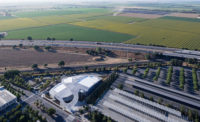From an Upper East Side townhouse to a SoHo storefront to a Long Island City industrial space, New York City’s Museum for African Art has had three different homes since opening to the public in 1984. While this nomadic existence was somewhat fitting for a fledgling institution showcasing the art of Africa and the African Diaspora, the growing museum required a world-class facility to handle and display the ancient objects, intricate crafts, and contemporary works that constitute its expanding series of temporary exhibitions.
That new facility, located at Fifth Avenue and 110th Street and overlooking Central Park, will link Manhattan’s famed Museum Mile to Harlem when it opens in April 2011. “The museum bridges cultures, but also shows our common humanity through African art,” says museum president Elsie McCabe Thompson.
Designed by Robert A.M. Stern Architects, the museum’s 75,000 square feet of galleries, lobby, event space, café, theater, shop, offices, library, and education center make up the lower floors of a 19-story residential tower. According to Stern, one of the greatest design challenges was ensuring that the museum was distinct from the rest of the building. Using precast concrete panels, the architects modulated the surface of the entire facade, but incorporated a unique pattern of trapezoidal windows over the museum floors. “It is a modern, abstract way of conveying a weaving element that is common in much of African art,” explains Stern.
The design team includes G TECTS Architecture (architect of record) and SLCE Architects (architect of record for core and shell). Yolande Daniels of Studio SUMO designed the first floor education space, and Andre Kikoski is the architect of the residential interiors.







